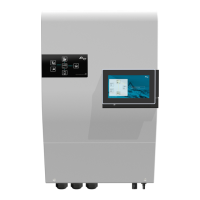Studer Innotec SA
next3
104 V 1.3 © Studer-Innotec SA next3 Tech manual
The next3 is a fully automatic solar and grid charger designed to guarantee an optimum
charge for most type of batteries: lead/liquid acid, lead/gel, AGM batteries or Lithium. The
battery charger enters automatically into
operation as soon as the irradiation is
sufficient, and the photovoltaic panel
voltage is sufficient.
The charging from the grid/genset is
performed according to the AC energy
management settings. When charging
from the grid/genset, the next3 follows the
same charging cycle as the solar.
The batteries can be fully charged by the
successive phases 1 to 4 described
hereunder:
1. Bulk phase
The bulk phase is the stage where the next3 applies the maximum charging current (if there
is enough energy available on solar and/or AC source) to charge the battery. This will lead to
an increase of the battery voltage up to the next phase voltage limit; absorption, equalisation
or floating, depending on the charging profile adjusted.
The bulk phase will allow a quick charge thanks to the high current. For lead batteries, this
phase will charge them up to 90% SOC.
It is important that the maximum battery charge current is set according to the battery
specifications to prevent damaging them. This current can be limited with the setting
"Charging current limit". The maximum charging current might not be reached due to diverse
conditions like the solar irradiation is not enough in an off-grid system, or the available power
from AC source is too low, or the ambient temperature is creating a derating on the power
electronic, etc...
Absorption phase
This constant voltage phase, mainly used in lead batteries, allow to charge the last percents
of the batteries. Because of keeping the voltage stable and the battery accepting less and
less energy, the charging current will diminish progressively.
It can be ended by time (if there is enough energy to keep the phase for longer periods) or
by current (if the battery ends his charge before the adjusted time)
Be aware that due to the current reduction during the phase, the power required to charge
the battery will also be reduced. This can cause a reduction of the PV production if the excess
energy is not used for other purposes than for charging the battery.

